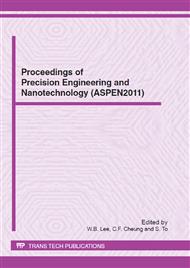p.600
p.606
p.612
p.618
p.624
p.629
p.634
p.640
p.645
Optimal Design of Microneedles Inserts into Skin by Numerical Simulation
Abstract:
The purpose of this research is to find the optimal design for biodegradable polymer microneedle patches. Based on the mechanical properties of different skin layers and the failure criterion of the material, this research designs a microneedle of four types and three sizes, then discusses the insertion force and the variation of stress during the process of PLA microneedle insertion into skin by numerical simulation. This research uses the dynamic finite element software ANSYS / LS-DYNA to simulate the processing for PLA microneedle inserts into skin. The master microneedle array was fabricated by the MEMS process. This research uses PDMS to fabricate the mould for microneedles. Finally, a biodegradable polymer polylactic acid (PLA) microneedle patch was fabricated using a PDMS mould micro hot embossing method.
Info:
Periodical:
Pages:
624-628
Citation:
Online since:
June 2012
Authors:
Keywords:
Price:
Сopyright:
© 2012 Trans Tech Publications Ltd. All Rights Reserved
Share:
Citation:


